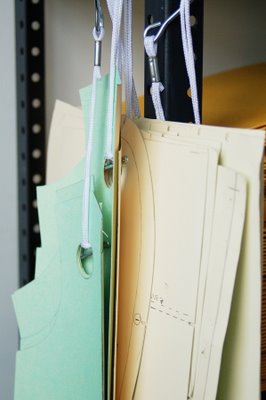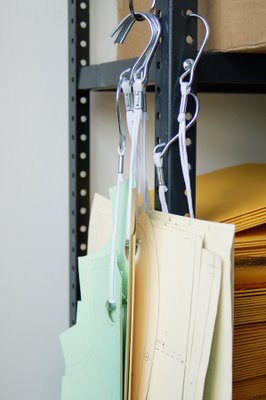Sample rooms used to be a common sight in the garment industry. Now that most pattern-making is done overseas, sample rooms are a luxury that many designers can’t afford. I was very fortunate, in school, to do an internship with a designer who had his own sample room, and I learned a great deal as a result of working directly with the sample makers. I did all my work in the sample room, from sketching designs to attending fittings with the models. It’s a great way to learn the business, and unfortunately it’s becoming a rare opportunity for many design students.

If you walk around Seventh Avenue (the garment district) and look up, you’ll still see some of these in the windows. They’re patterns made of oak tag, which is essentially the same paper card stock that comprise manila file folders. An oak tag pattern is a sure sign of a sample room. Which either means it’s a small designer (like us) who does his or her own pattern-making or it’s a very high-end company who can afford to have a sample room.
Oak tag lasts longer than pattern paper, and if you’re using a pattern many times it’s often worthwhile to trace it onto oak tag to preserve it. Also, if you trace around the oak tag pattern onto your fabric using chalk, you can cut the pattern directly from your fabric without the pattern itself getting in the way. It’s faster than pinning or weighting a paper pattern piece to the fabric before cutting.

We use oak tag for two types of patterns at Oliver + S. Our slopers, or basic fit templates, are made from oak tag so they can be quickly and accurately traced onto paper and then manipulated and altered to create a pattern for a new style or design. We also trace our block patterns onto oak tag. These are our finished patterns that are used to develop new styles when a particular fit is desired.
Someday we might change to a digital pattern-making system. It’s more efficient and would probably save hours of pattern making. Alterations would be much faster as well. But part of me would feel a little sad to leave the drafting side of the business behind. I enjoy getting out my box of pattern-making tools, unrolling a length of pattern paper, and reaching for the oak tag.
I’m with you Liesl. I hold very dear my patternmaking tools, and I love a quiet day in the studio to get down to the business of making card patterns.
I can’t bear store bought patterns on fine tissue – I always convert favourite patterns to card as it’s so, so much nicer to work with.
Undeniably fascinating! I will admit that I still do not understand the concept of ‘sloper’ although I’ve seen it used in text as well as heard it in conversation with those more familiar. There is even a local class on how to ‘do it’, but… well… another lesson/concept to learn, I’m sure.
Hi Liesl, love your blog and just bought my 1st Oliver + s pattern….and now to make the party dress for my 2 darlings….won’t they look sweet this summer…thanks for sharing about patterns..I so love card patterns so much easier to work with than tissue.
interesting post. thank you.
Liesl, I have some small quantities of oaktag (10 yards or less) that are wrapped tightly. Any advice as to how to flatten it out to use? Thanks!
Where can I buy oaktag for the home sewer for my slopers? I have been searching and I don’t need a huge amount. Thanks!
I have maybe 300 oak tag dress patterns that were made by my deceased aunt, formerly a successful NYC dress designer with her own label for custom-made dresses. I don’t know what I should do with these patterns. Can I donate or sell them somewhere? They look just like the ones shown here, hanging on little hooks.